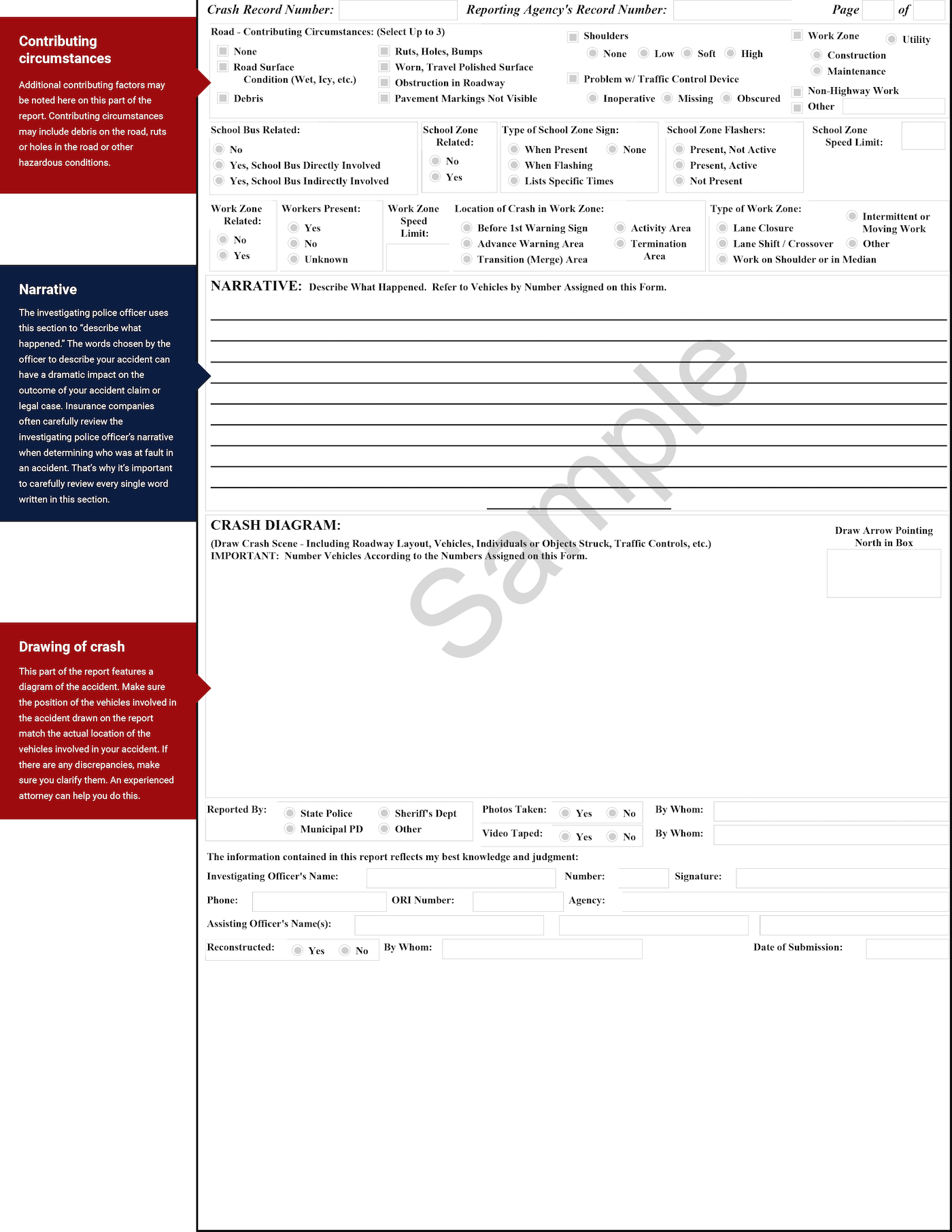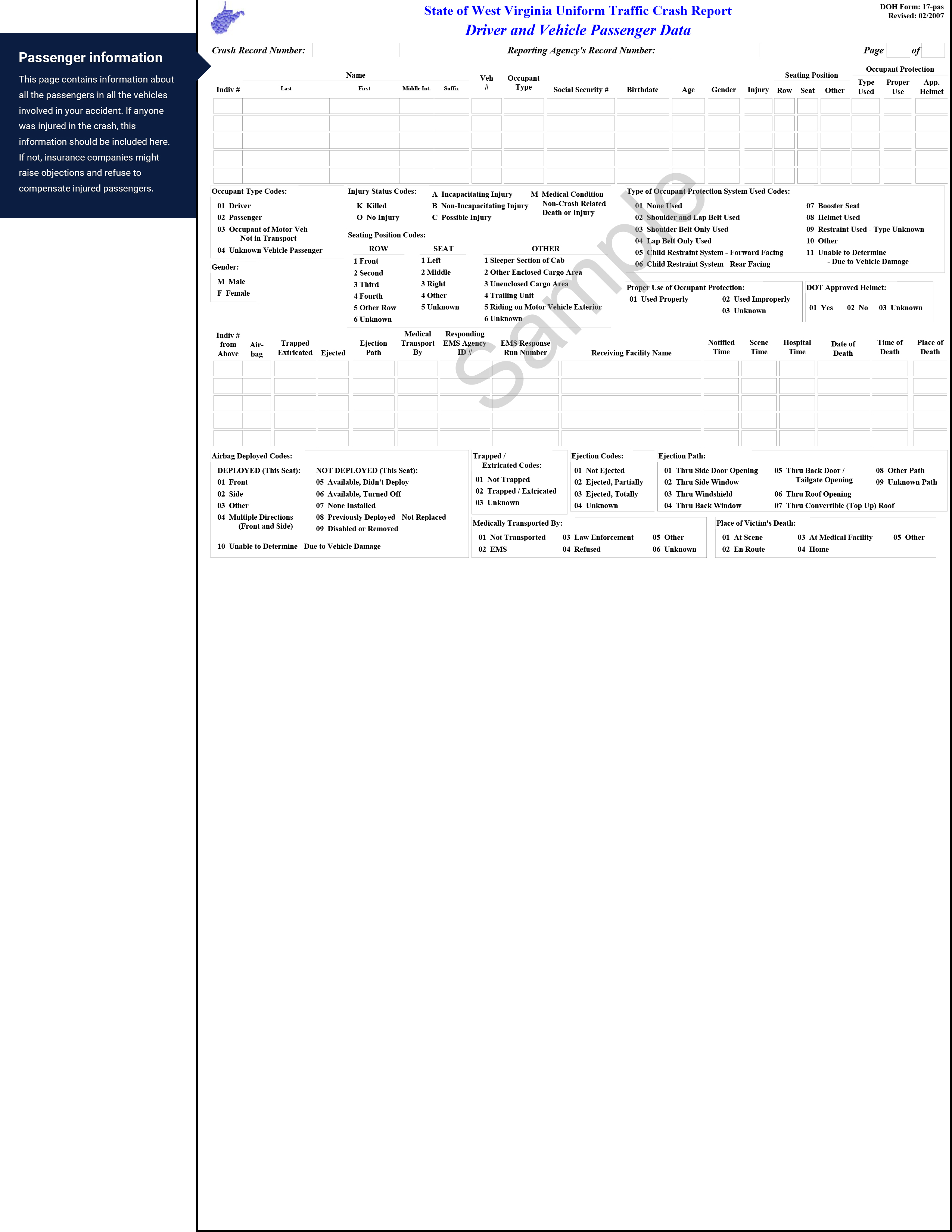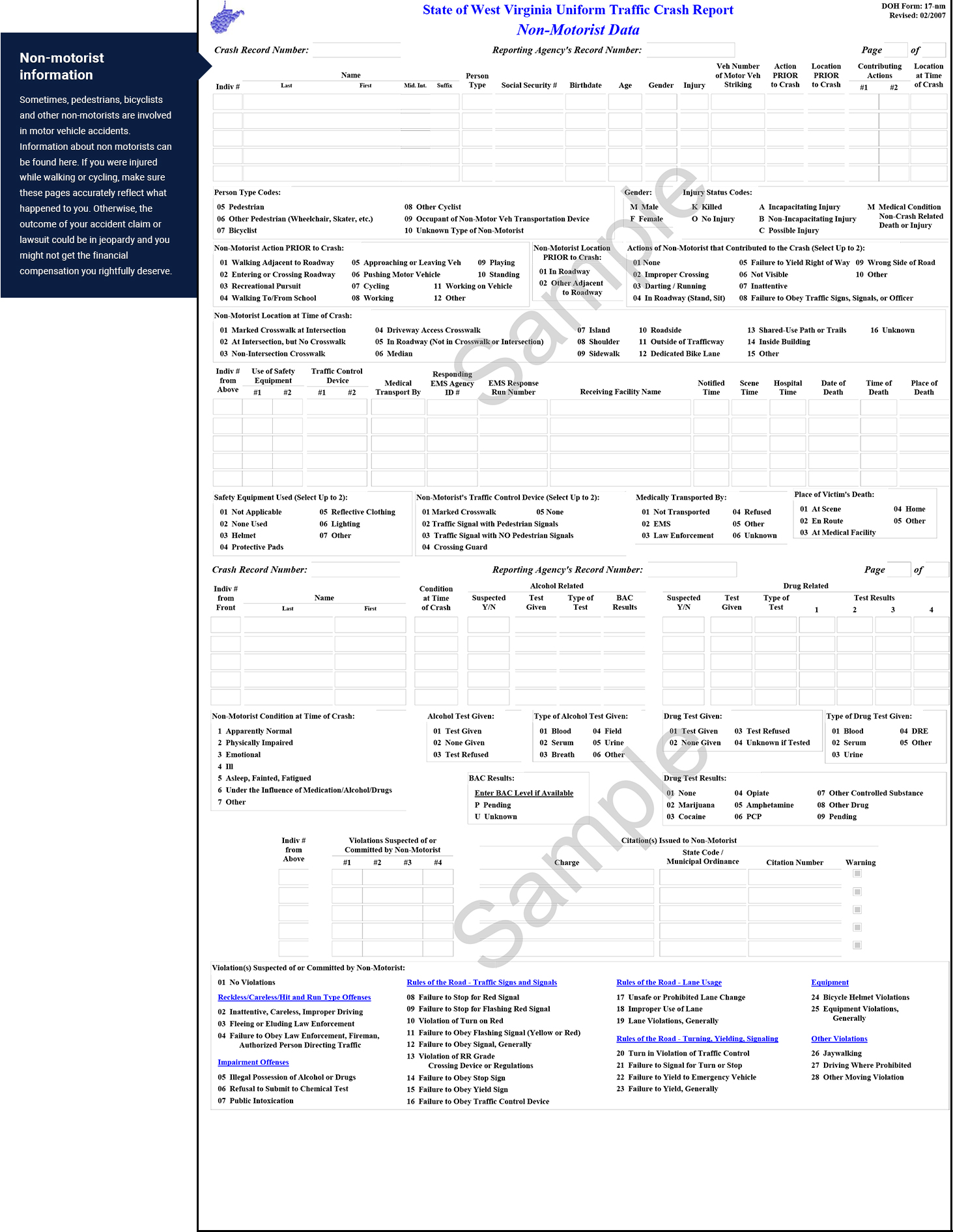Your Guide to The West Virginia Accident Report
After an auto accident, you need to know exactly what the investigating police officer had to say. The officer's account of the car wreck is contained in the West Virginia Uniform Traffic Crash Report. Insurance companies require this report to process a car accident claim, and the report itself serves as a vital piece of evidence that your attorney will need to build a case. That's why it's so important to understand what it says.
As a guide, we have provided a sample copy of the crash report used in West Virginia with our comments on how to read the document. Note that if you were involved in an accident in another state, the accident report used will be slightly different. Our attorneys are familiar with Ohio and Pennsylvania accident reports as well and routinely handle cases in those states.
If you have any questions about the information on your report - or if you notice any discrepancies - you will need legal help right away. Reach out to Recht Law Offices immediately. Call (304) 748-5850 to schedule your free case evaluation.

Page 1
Date, time and location
This section of the West Virginia Uniform Traffic Crash Report contains information about the exact time, date and location of your accident. Make sure this information is accurate. Even a small mistake could jeopardize the outcome of a potential accident claim or a pending legal case or lawsuit seeking financial compensation.
Type of accident and where it happened
This section of the report outlines where the accident happened (at an intersection, exit ramp, etc.) as well as the type of accident (rear end, head-on, sideswipe, etc.). Here again, it’s critical that your accident report accurately reflects what happened. If you disagree with the description of your accident, make sure you voice your concerns. An attorney can assist with this and work with you to set the record straight.
Cause of accident
The conditions that resulted in the cause of the accident can be found in this part of the accident report. These conditions can include the weather (rain, snow, etc.), road surface conditions (dry, wet, etc.) and other factors. In particular, the “first harmful event” listed here often plays a significant role in the cause of an accident. Harmful events include “jackknife,” “overturn/rollover” and “fire/explosion.” This part of the report also states if the collision involved pedestrians and cyclists, as well as other situations, including work zones, guardrails or other traffic barriers.

Page 2
Contributing circumstances
Additional contributing factors may be noted here on this part of the report. Contributing circumstances may include debris on the road, ruts or holes in the road or other hazardous conditions.
Narrative
The investigating police officer uses this section to “describe what happened.” The words chosen by the officer to describe your accident can have a dramatic impact on the outcome of your accident claim or legal case. Insurance companies often carefully review the investigating police officer’s narrative when determining who was at fault in an accident. That’s why it’s important to carefully review every single word written in this section.
Drawing of crash
This part of the report features a diagram of the accident. Make sure the position of the vehicles involved in the accident drawn on the report match the actual location of the vehicles involved in your accident. If there are any discrepancies, make sure you clarify them. An experienced attorney can help you do this.

Page 3
Vehicle information
Detailed information about all the vehicles involved in the accident can be found here, especially if a commercial vehicle, large truck or bus was involved in the collision. This information includes the make, model and year of the vehicles involved in the crash. Information about the direction a vehicle was traveling at the time of the crash is also located here.
Crash avoidance and vehicle damage
If you or another driver tried to avoid causing a collision, this information should be included here. This may include evidence of skid marks on the road or other “crash avoidance maneuvers.” Another important piece of information can be found on this part of the report as well – the “extent of damage” to the vehicle. Make sure this entry is accurate. If your vehicle was severely damaged, make sure it says so. What is written here could dramatically change how much money you receive for your accident-related expenses.
Page 4
Crash events and diagrams
“Crash events” can cover a wide range, from “jackknife” accidents to “equipment failure” and “overturn/rollover” accidents. There are also five different diagrams to choose from depending on what type of vehicle was involved in the crash. This includes cars, motorcycles, passenger vehicles with a towing unit, buses and tractor-trailers. Below, you can also find information about any units being towed by the vehicles involved in the crash.

Page 5
Driver information
The names and addresses of the drivers involved in the accident are located here. In addition, if the driver had any license restrictions (including whether their driver’s license was valid, suspended or revoked) can be found here and can play an important role in the outcome of your accident claim, lawsuit or other pending legal action.
Alcohol involvement
If the other driver was intoxicated at the time of your accident, you can find this information here. The investigating police officer will make a note if the driver was given an alcohol test, if they passed such a test and their blood alcohol concentration (BAC) results. Pay close attention to this information. If you suspect the other driver was intoxicated but the report doesn’t say so here, make sure you speak up and voice your concerns. An attorney can help you do this.

Page 6
Traffic citations
If the investigating police officer issued any citations for traffic violations, this information should be located here. Traffic citations can cover a wide range, from driving while impaired to speeding, failure to obey a stop sign and driving while license suspended or revoked.
Driver statement
You and the other driver(s) involved in your accident will likely be interviewed by the investigating police officer. Your statements will likely be included here. What you say matters. That’s why it’s important to speak up if you believe your statement listed here does not accurately reflect what happened. In addition, pay close attention to what the other driver said or wrote about your accident. If the other driver admitted causing your collision (or blames you), the other driver’s statement could significantly influence how much money you receive for your accident-related expenses.

Page 7
Passenger information
This page contains information about all the passengers in all the vehicles involved in your accident. If anyone was injured in the crash, this information should be included here. If not, insurance companies might raise objections and refuse to compensate injured passengers.

Page 8
Driver statement
You and the other driver(s) involved in your accident will likely be interviewed by the investigating police officer. Your statements will likely be included here. What you say matters. That’s why it’s important to speak up if you believe your statement listed here does not accurately reflect what happened. In addition, pay close attention to what the other driver said or wrote about your accident. If the other driver admitted causing your collision (or blames you), the other driver’s statement could significantly influence how much money you receive for your accident-related expenses.

Pages 9 and 10
Non-motorist information
Sometimes, pedestrians, bicyclists and other non-motorists are involved in motor vehicle accidents. Information about non motorists can be found here. If you were injured while walking or cycling, make sure these pages accurately reflect what happened to you. Otherwise, the outcome of your accident claim or lawsuit could be in jeopardy and you might not get the financial compensation you rightfully deserve.

Pages 11 and 12
Commercial vehicles
Detailed information about commercial vehicles involved in your accident should be included on these two pages. These pages can be very important if you or your attorney need to contact the company the commercial driver works for. The contents of the truck that caused your collision should also be listed on these pages.

Page 13
Large diagram
Sometimes, the investigating police officer will draw a larger diagram of the accident. Like the smaller diagram, make sure the police officer’s drawing of your accident is accurate. You know best what happened. Make sure the facts are correct.
Click here to download a printable version.
